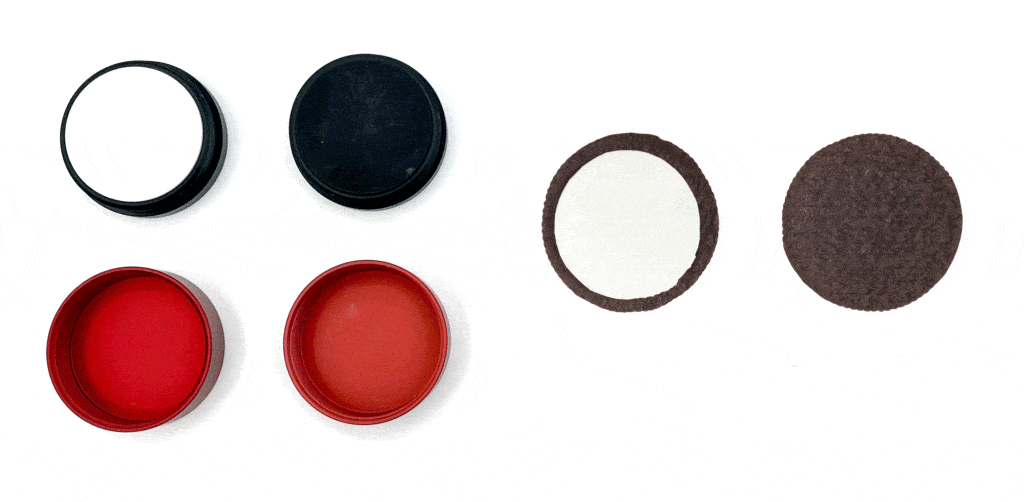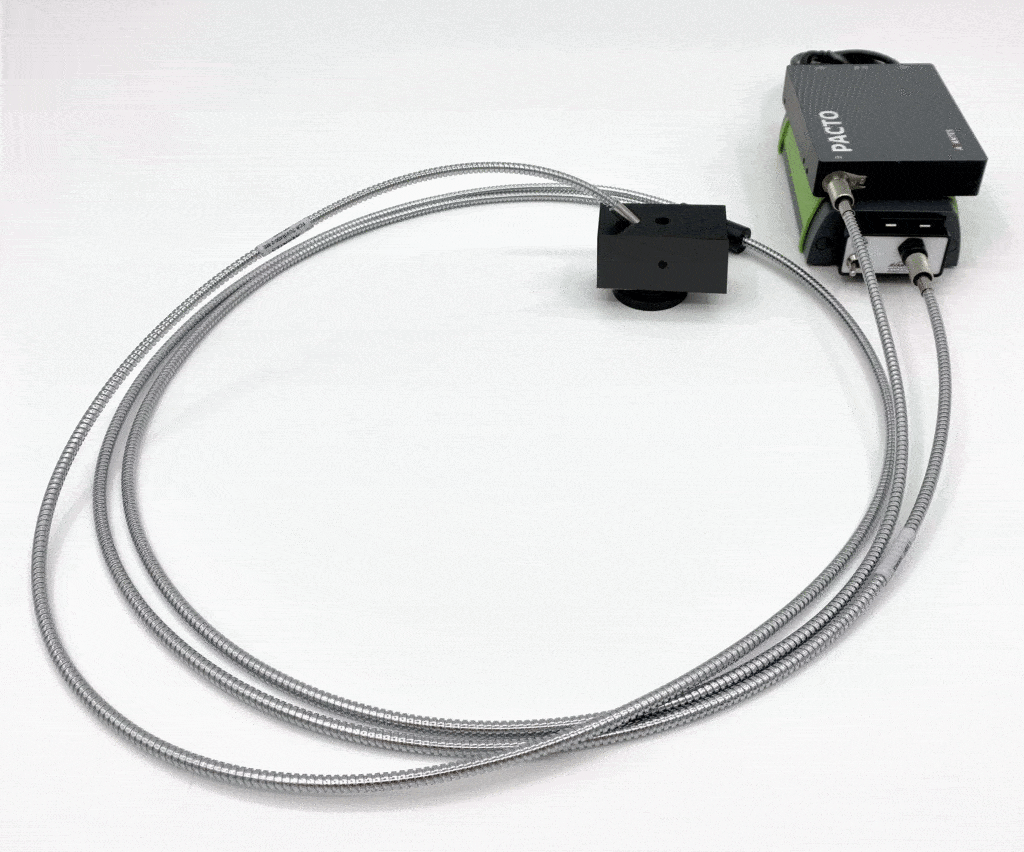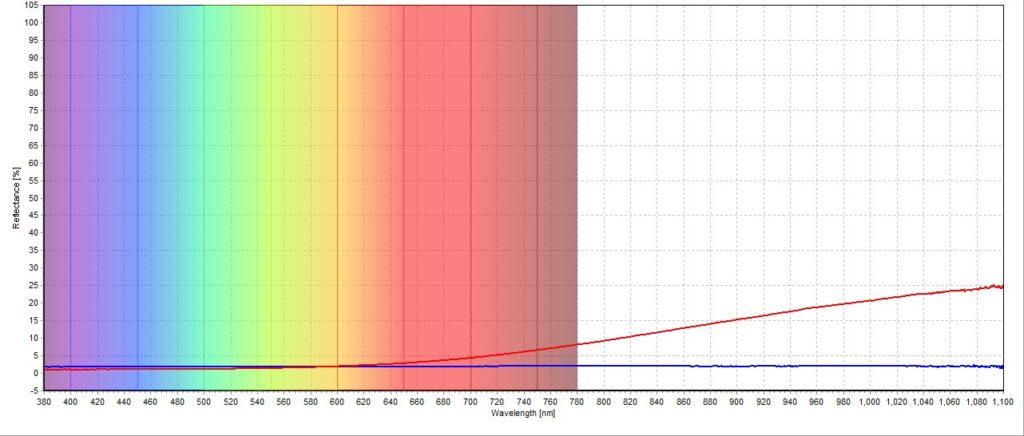Oreo™ vs. An Avantes Reference Tile.
Background/Applications:
We were intrigued by a claim that the composition of an Oreo™ cookie’s interior, consisting of two chocolate biscuits and a sweet cream filling, bore a resemblance to a PTFE reflection reference tile. As such, we resolved to conduct an experiment to compare it with the authentic accessory. Beloved the world over and particularly by our engineering team, we already had a stock of such cookies at our disposal for the purposes of the experiment. Proceeding, we determined the necessary spectroscopy arrangement, and then aimed to ascertain the physical similarities of the two materials. To accomplish this, we devised a plan to open up the cookie, scan the creme filling, and assess its resemblance to our WS-2 white reference tile.

Figure 1: Oreo cookie sample and reference tiles (From left to right: WS-2, BS-2, Oreo™ cookie creme filling, and Oreo™ cookie chocolate biscuit).
This experiment aims to determine the efficacy of an Oreo™ as both a white and black reference by comparing it to our standard reference tiles. (Figure 1). Our reference tiles will be used as the reference for diffuse reflectance measurements of the cookie. Measurements will also be taken in the colorimetry module to determine how effective Oreo™ cookies are for color applications, with our reference tiles once again being used as the reference.
Description of System:

Figure 2: Experimental setup for tile measurement. The probe is mounted into the probe holder, which is then placed on top of the Oreo sample or reference tile.
The setup for this experiment (Figure 2) was based on our brand new AvaSpec-PCT2048CL, better known as the NEXOS™. This compact instrument is the next-generation photonics backbone spectrometer, designed to empower a wide range of applications in various industries. This device is built using our new semi-automated manufacturing process (AKA “Ava-Mation”) that ensures higher levels of consistency and reproducibility unit-to-unit. The NEXOS™ offers USB2.0 communication as well as RS232 and SPI communication protocols, a CMOS linear array detector (2048 and 4096 pixel options), ultra-low stray light as low as 0.1%, and a signal/noise ratio of 375:1. Furthermore, this spectrometer can be customized with a wide range of gratings (13 total available) and the replaceable slit option is now standard for non-OEM units, which provides even more flexibility for a variety of application needs.
The light source used for this experiment was the AvaLight-Hal-S-Mini, a compact, stabilized halogen light source. Designed to work from visible light to near-infrared, the AvaLight-Hal-S-Mini is equipped with an adjustable focusing on the fiber connection to maximize output power at desired wavelengths. Other features of the AvaLight-Hal-S-Mini include an internal TTL shutter that is controllable from an AvaSpec spectrometer, and the ability to directly attach a cuvette holder, attenuator, or a combined cuvette holder and attenuator.
Other accessories used for this experiment included a white reference tile (WS-2) that was used as the reference for both the reflection measurement and color measurement, a black reference tile (BS-2) that was used to compare to the chocolate biscuit portion of the Oreo™ cookie, a 400-micron core fiber optic reflection probe (FCR-7UVIR400-2-ME), and a probe holder (RPH-1) to hold the probe consistently at a 45-degree angle.
Description of Methodology:
The probe was mounted into the probe holder, which was individually placed on each side of an Oreo™ cookie for analysis. The probe holder established a consistent measurement distance, which in turn resulted in measurements that could be accurately compared. The WS-2 white reference tile was measured first to set our reference, and it was also measured under the probe holder to ensure consistency in measuring distance. The BS-2 black reference tile was also measured for comparison to the chocolate biscuit side of the Oreo™ cookie.
For data analysis, we used two modes in AvaSoft, our exclusive custom software package. The first mode used was Reflectance mode. This mode is designed for reflection applications, where the reference measurement will report 100% and the dark measurement will report 0%. In this experiment, the WS-2 white reference tile was used as the reference. The second mode used was Color mode, which is included with AvaSoft-All or available as a single add-on module. This mode is specifically designed for color measurements, with the ability to measure parameters such as L*, a*, and b*. A live chart displays the sample measurement on an L*a*b* graph, a separate reference color can be assigned for dL, da, db, and dE measurements, and all data can be saved to an Excel or text file. We used an integration time of approximately 50 milliseconds, which can be adjusted to increase or decrease the amount of light being measured at one time and affects the overall magnitude of the reported spectrum. We set averaging to 10, meaning ten values were averaged together to provide more consistent spectra results.
Test Data and Results:
Displayed below are the reflectance spectra of the Oreo™ samples and reference tiles and a table of the Color mode data for the Oreo samples and reference tiles.
Download Avasoft and Excel Data

Figure 3: Reflectance spectra of the Oreo™ creme filling sample (red) and WS-2 reference tile (blue).

Figure 4: Reflectance spectra of the Oreo™ chocolate biscuit sample (red) and BS-2 reference tile (blue).
Analysis:
As we suspected, there is no comparison between the Oreo™ cookie crème filling and our powerful reference tile. The Oreo™ creme filling gives reflectance values in the range of 30-50% over 380-1100 nm (Figure 3) and the chocolate biscuit gives reflectance values in the range of 0-25% over the same spectral range (Figure 4). The creme filling reported an L* value much lower than the WS-2 tile, an a* value close to the WS-2 tile, and a b* value higher than the WS-2 tile (Table 1). The chocolate biscuit reported an L* lower than the BS-2 tile, an a* value higher than the BS-2 tile, and a b* value higher than the BS-2 tile. The lower L* value of the biscuit is surprising, but it may indicate that the Oreo sample is a less reflective material than the BS-2 tile material, which can be seen in the reflectance measurements from 380-600 nm.
Conclusion:
It is no surprise that the reflectance and color values of the Oreo™ samples are not able to match the consistency and reliability seen in our reference tiles. This month’s experiment was more lighthearted and written to be fun but also to highlight the need for accurate, clean reference tiles when performing measurements. Our new AvaSpec-NEXOS was featured for its variety of uses, including the reflection and color measurements as shown in this experiment. The AvaLight-Hal-S-Mini is an equally versatile light source that is well-suited for many applications. Our WS-2 and BS-2 reference tiles provide white and black references, respectively, that are both consistent and reliable. Please contact Avantes for more information on the configuration that is best suited for your data collection.
 My Cart
My Cart 
